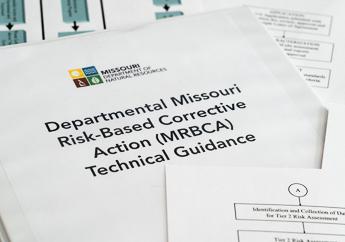
The department works with sites, mainly those enrolled in the department's Brownfields/ Voluntary Cleanup Program (BVCP) or Underground Storage Tank Program, to investigate and clean up any release of chemicals into the environment — soil, ground water, surface water, air — that may pose potential threats to human health or the environment. It is not always possible or practical to remove all traces of contamination, due to technological, physical or financial limitations. In those cases, the department uses a risk-based corrective action process, where the site cleanup is based on the potential risk the contamination poses to human health and environmental based on current and future site use.
The department adopted a risk-based corrective action process, also known as RBCA (pronounced "Rebecca"), that provides a framework for remediation, or cleanup, decisions at contaminated sites. The MRBCA process is similar to other risk-based approaches used by other states and EPA regions. The risk-based framework can simplify the site investigation and cleanup processes and speed up departmental decision-making by clearly defining risk-based endpoints to focus limited resources (both private and public) on sites with the highest actual or potential risks. Risk-based corrective action protects human health and the environment while allowing constructive current and future site use.
Establishing acceptable cleanup levels is premised on current and planned future land use (residential or non-residential) and the paths the contamination could take (exposure pathways) from the contamination source to humans, animals or the environment (receptors). Exposure pathways may be direct, such as contact with contaminated surface soil, or indirect, such as volatizing chemicals from contaminated soil or groundwater entering building structures (vapor intrusion). A warehouse that is being redeveloped as residential apartments would require different cleanup levels and controls than if industrial or commercial use were to continue. If determined to be safe, contamination may be left in place as long as appropriate institutional or engineering controls are established to ensure long-term protection by preventing exposure to unacceptable levels of residual contamination. For more information about controls, visit the department's tools and controls webpage.
The department, with the assistance of stakeholders, developed two separate technical guidance documents for Missouri's risk-based corrective action process.
- Tanks MRBCA Guidance - Applies to petroleum releases at petroleum storage tank sites.
- Departmental MRBCA Guidance - Applies mainly to voluntary departmental risk-based cleanups overseen by BVCP.
In 2009, the department, with the assistance of stakeholders, developed a risk-based corrective action rule to codify the departmental MRBCA process and its key elements and methodologies. The Risk-Based Corrective Action Process rule, found in Code of State Regulations 10 CSR 25-18.018, became effective on Oct. 31, 2009. Both the rule and the current departmental MRBCA guidance are used to guide the investigation, risk assessment and cleanup of contaminated sites.

